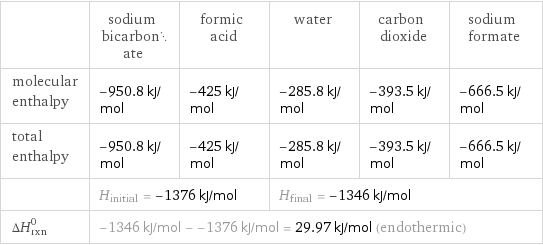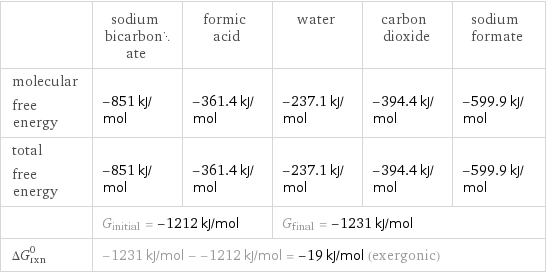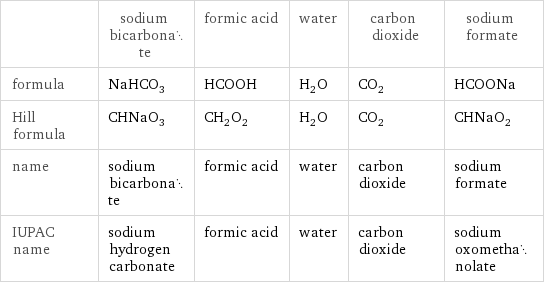Input interpretation

NaHCO_3 sodium bicarbonate + HCOOH formic acid ⟶ H_2O water + CO_2 carbon dioxide + HCOONa sodium formate
Balanced equation

Balance the chemical equation algebraically: NaHCO_3 + HCOOH ⟶ H_2O + CO_2 + HCOONa Add stoichiometric coefficients, c_i, to the reactants and products: c_1 NaHCO_3 + c_2 HCOOH ⟶ c_3 H_2O + c_4 CO_2 + c_5 HCOONa Set the number of atoms in the reactants equal to the number of atoms in the products for C, H, Na and O: C: | c_1 + c_2 = c_4 + c_5 H: | c_1 + 2 c_2 = 2 c_3 + c_5 Na: | c_1 = c_5 O: | 3 c_1 + 2 c_2 = c_3 + 2 c_4 + 2 c_5 Since the coefficients are relative quantities and underdetermined, choose a coefficient to set arbitrarily. To keep the coefficients small, the arbitrary value is ordinarily one. For instance, set c_1 = 1 and solve the system of equations for the remaining coefficients: c_1 = 1 c_2 = 1 c_3 = 1 c_4 = 1 c_5 = 1 Substitute the coefficients into the chemical reaction to obtain the balanced equation: Answer: | | NaHCO_3 + HCOOH ⟶ H_2O + CO_2 + HCOONa
Structures

+ ⟶ + +
Names

sodium bicarbonate + formic acid ⟶ water + carbon dioxide + sodium formate
Reaction thermodynamics
Enthalpy

| sodium bicarbonate | formic acid | water | carbon dioxide | sodium formate molecular enthalpy | -950.8 kJ/mol | -425 kJ/mol | -285.8 kJ/mol | -393.5 kJ/mol | -666.5 kJ/mol total enthalpy | -950.8 kJ/mol | -425 kJ/mol | -285.8 kJ/mol | -393.5 kJ/mol | -666.5 kJ/mol | H_initial = -1376 kJ/mol | | H_final = -1346 kJ/mol | | ΔH_rxn^0 | -1346 kJ/mol - -1376 kJ/mol = 29.97 kJ/mol (endothermic) | | | |
Gibbs free energy

| sodium bicarbonate | formic acid | water | carbon dioxide | sodium formate molecular free energy | -851 kJ/mol | -361.4 kJ/mol | -237.1 kJ/mol | -394.4 kJ/mol | -599.9 kJ/mol total free energy | -851 kJ/mol | -361.4 kJ/mol | -237.1 kJ/mol | -394.4 kJ/mol | -599.9 kJ/mol | G_initial = -1212 kJ/mol | | G_final = -1231 kJ/mol | | ΔG_rxn^0 | -1231 kJ/mol - -1212 kJ/mol = -19 kJ/mol (exergonic) | | | |
Equilibrium constant
![Construct the equilibrium constant, K, expression for: NaHCO_3 + HCOOH ⟶ H_2O + CO_2 + HCOONa Plan: • Balance the chemical equation. • Determine the stoichiometric numbers. • Assemble the activity expression for each chemical species. • Use the activity expressions to build the equilibrium constant expression. Write the balanced chemical equation: NaHCO_3 + HCOOH ⟶ H_2O + CO_2 + HCOONa Assign stoichiometric numbers, ν_i, using the stoichiometric coefficients, c_i, from the balanced chemical equation in the following manner: ν_i = -c_i for reactants and ν_i = c_i for products: chemical species | c_i | ν_i NaHCO_3 | 1 | -1 HCOOH | 1 | -1 H_2O | 1 | 1 CO_2 | 1 | 1 HCOONa | 1 | 1 Assemble the activity expressions accounting for the state of matter and ν_i: chemical species | c_i | ν_i | activity expression NaHCO_3 | 1 | -1 | ([NaHCO3])^(-1) HCOOH | 1 | -1 | ([HCOOH])^(-1) H_2O | 1 | 1 | [H2O] CO_2 | 1 | 1 | [CO2] HCOONa | 1 | 1 | [HCOONa] The equilibrium constant symbol in the concentration basis is: K_c Mulitply the activity expressions to arrive at the K_c expression: Answer: | | K_c = ([NaHCO3])^(-1) ([HCOOH])^(-1) [H2O] [CO2] [HCOONa] = ([H2O] [CO2] [HCOONa])/([NaHCO3] [HCOOH])](../image_source/e6fdb0b2813ae2e9d25305b3c951e4a8.png)
Construct the equilibrium constant, K, expression for: NaHCO_3 + HCOOH ⟶ H_2O + CO_2 + HCOONa Plan: • Balance the chemical equation. • Determine the stoichiometric numbers. • Assemble the activity expression for each chemical species. • Use the activity expressions to build the equilibrium constant expression. Write the balanced chemical equation: NaHCO_3 + HCOOH ⟶ H_2O + CO_2 + HCOONa Assign stoichiometric numbers, ν_i, using the stoichiometric coefficients, c_i, from the balanced chemical equation in the following manner: ν_i = -c_i for reactants and ν_i = c_i for products: chemical species | c_i | ν_i NaHCO_3 | 1 | -1 HCOOH | 1 | -1 H_2O | 1 | 1 CO_2 | 1 | 1 HCOONa | 1 | 1 Assemble the activity expressions accounting for the state of matter and ν_i: chemical species | c_i | ν_i | activity expression NaHCO_3 | 1 | -1 | ([NaHCO3])^(-1) HCOOH | 1 | -1 | ([HCOOH])^(-1) H_2O | 1 | 1 | [H2O] CO_2 | 1 | 1 | [CO2] HCOONa | 1 | 1 | [HCOONa] The equilibrium constant symbol in the concentration basis is: K_c Mulitply the activity expressions to arrive at the K_c expression: Answer: | | K_c = ([NaHCO3])^(-1) ([HCOOH])^(-1) [H2O] [CO2] [HCOONa] = ([H2O] [CO2] [HCOONa])/([NaHCO3] [HCOOH])
Rate of reaction
![Construct the rate of reaction expression for: NaHCO_3 + HCOOH ⟶ H_2O + CO_2 + HCOONa Plan: • Balance the chemical equation. • Determine the stoichiometric numbers. • Assemble the rate term for each chemical species. • Write the rate of reaction expression. Write the balanced chemical equation: NaHCO_3 + HCOOH ⟶ H_2O + CO_2 + HCOONa Assign stoichiometric numbers, ν_i, using the stoichiometric coefficients, c_i, from the balanced chemical equation in the following manner: ν_i = -c_i for reactants and ν_i = c_i for products: chemical species | c_i | ν_i NaHCO_3 | 1 | -1 HCOOH | 1 | -1 H_2O | 1 | 1 CO_2 | 1 | 1 HCOONa | 1 | 1 The rate term for each chemical species, B_i, is 1/ν_i(Δ[B_i])/(Δt) where [B_i] is the amount concentration and t is time: chemical species | c_i | ν_i | rate term NaHCO_3 | 1 | -1 | -(Δ[NaHCO3])/(Δt) HCOOH | 1 | -1 | -(Δ[HCOOH])/(Δt) H_2O | 1 | 1 | (Δ[H2O])/(Δt) CO_2 | 1 | 1 | (Δ[CO2])/(Δt) HCOONa | 1 | 1 | (Δ[HCOONa])/(Δt) (for infinitesimal rate of change, replace Δ with d) Set the rate terms equal to each other to arrive at the rate expression: Answer: | | rate = -(Δ[NaHCO3])/(Δt) = -(Δ[HCOOH])/(Δt) = (Δ[H2O])/(Δt) = (Δ[CO2])/(Δt) = (Δ[HCOONa])/(Δt) (assuming constant volume and no accumulation of intermediates or side products)](../image_source/a578bb630be881d5f494bd3ca1f712bb.png)
Construct the rate of reaction expression for: NaHCO_3 + HCOOH ⟶ H_2O + CO_2 + HCOONa Plan: • Balance the chemical equation. • Determine the stoichiometric numbers. • Assemble the rate term for each chemical species. • Write the rate of reaction expression. Write the balanced chemical equation: NaHCO_3 + HCOOH ⟶ H_2O + CO_2 + HCOONa Assign stoichiometric numbers, ν_i, using the stoichiometric coefficients, c_i, from the balanced chemical equation in the following manner: ν_i = -c_i for reactants and ν_i = c_i for products: chemical species | c_i | ν_i NaHCO_3 | 1 | -1 HCOOH | 1 | -1 H_2O | 1 | 1 CO_2 | 1 | 1 HCOONa | 1 | 1 The rate term for each chemical species, B_i, is 1/ν_i(Δ[B_i])/(Δt) where [B_i] is the amount concentration and t is time: chemical species | c_i | ν_i | rate term NaHCO_3 | 1 | -1 | -(Δ[NaHCO3])/(Δt) HCOOH | 1 | -1 | -(Δ[HCOOH])/(Δt) H_2O | 1 | 1 | (Δ[H2O])/(Δt) CO_2 | 1 | 1 | (Δ[CO2])/(Δt) HCOONa | 1 | 1 | (Δ[HCOONa])/(Δt) (for infinitesimal rate of change, replace Δ with d) Set the rate terms equal to each other to arrive at the rate expression: Answer: | | rate = -(Δ[NaHCO3])/(Δt) = -(Δ[HCOOH])/(Δt) = (Δ[H2O])/(Δt) = (Δ[CO2])/(Δt) = (Δ[HCOONa])/(Δt) (assuming constant volume and no accumulation of intermediates or side products)
Chemical names and formulas

| sodium bicarbonate | formic acid | water | carbon dioxide | sodium formate formula | NaHCO_3 | HCOOH | H_2O | CO_2 | HCOONa Hill formula | CHNaO_3 | CH_2O_2 | H_2O | CO_2 | CHNaO_2 name | sodium bicarbonate | formic acid | water | carbon dioxide | sodium formate IUPAC name | sodium hydrogen carbonate | formic acid | water | carbon dioxide | sodium oxomethanolate